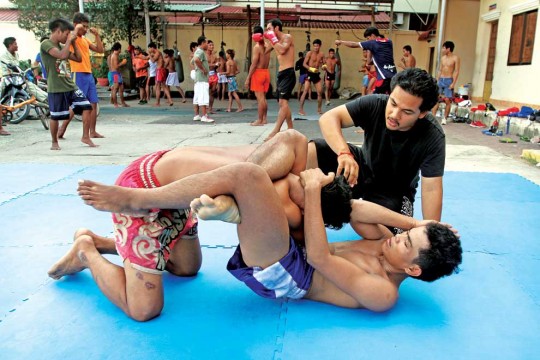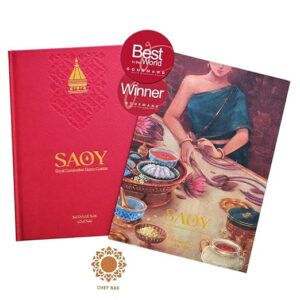Boak Chambab is Cambodian traditional wrestling; a sport in which two opponents try to pin (hold) each other’s back to the ground. It has been practiced as far back as the Angkor period and is depicted on the bas-relief of a certain temple.

Boak Cham Bab is a folk wrestling that originated in Cambodia. The fact that women compete in this particular wrestling technique makes it special. In classical wrestling, participants wear colorful loincloths and begin the match with a long dance lasting several minutes. By doing so, the wrestlers would warm their muscles up, which is a way to honor their coaches. As soon as they hear the command, they lash out at one another with ferocity, attempting to throw each other off balance.
What Is Khmer Boak Chambab?
Boak Chambab is traditional Cambodian wrestling, a sport in which two opponents try to pin (hold) each other’s back to the ground. It has been practiced as far back as the Angkor period and is depicted on the bas-relief of a certain temple.
The earliest form of Khmer traditional wrestling was called Maloyuth, created in 788 A.D. It evolved to the current form of wrestling, Bok Cham Bab, in the 8th century. Although predominantly a male sport today, Khmer wrestling was once practiced by both sexes as female wrestlers are also displayed on the Banteay Srei temple.
In Khmer wrestling, dancing is as important as wrestling. A match consists of three rounds. Wrestlers perform pre-match ritual dancing before the match in which the wrestlers dance and move to the music. A wrestler wins a match by two out of three rounds. However, after each round, the loser is asked if he still wishes to continue with the match.
Drum beats traditionally accompany the Boak Cham Bab match; two drums are known as Skor Nhi (female drum) and Skor Chhmol (male drum). Traditional matches are held at the Cambodian National Olympic Stadium during the Khmer New Year and other Cambodian holidays.
This folk sport used to be a means of choosing tribal and regional leaders. In the olden times, elders taught the young in their village on the full moon night after harvesting. It would take place on a rice paddy outside the village and under the moonlight. Today, the sport is still practiced in Pursat and Kampong Chhnang wrestling clubs.
How Do Participants Perform Khmer Bok Cham Bab?
Players appear to be the real warriors trapped in a surreal battle duel while the following drums beat rapidly, preserving the match’s tempo. The combat will be called off when neither side can gain an edge, and the dance will restart.
Participants will swap between wrestling and dancing for a long time. You’ll be rewarded with a point in the game if you successfully toss your opponent and cause them to land on their back.
The judge has the final say on who wins each of the three rounds. The ultimate winner is the one who has won two of the three rounds of the competition. Wrestlers can only use their arms and legs in the competition.
How Did Khmer Physical Sport Take Place?
Historically, this activity fulfilled three vital functions in Cambodian traditional wrestling:
- Avoiding fighting;
- Maintaining health; and
- Training to win in a war if the necessity arises.
Wrestling means determining the strength and might of the toughest wrestlers to select tribe and local leaders.
The village seniors would instruct the community youth in wrestling because wrestling schools didn’t exist at the time.
On the first night of the full moon following harvest, they scoured the area for the finest young men and selected those with comparable characteristics, such as maturity, size, and height, for the competition.
The rice paddies in the community would be used as a field to teach the guidelines and practices of the sport.
The prominence of wrestling’s origins in Cambodian culture may be seen in the country’s festivals and festivities, where the practice of moonlight wrestling can still be seen.
Today’s newer generation of Khmer wrestlers competes for more for sport than for honor. They participate in it for enjoyment, such as on important occasions like Khmer New Year, Bonn Phchum Ben, and Bonn Kathen.
When planning your trip to Cambodia, remember the days when traditional sports occur. You will be amazed!
Legendary Wrestling Figure Sees Great Prospects in Cambodia
The legendary Iranian wrestler Komeil Ghasemi has been named head coach of Cambodia’s national wrestling squad since October 2020.
The Wrestling Federation of Cambodia (WFC) has talked openly of its goal to strengthen the sport in preparation for the Southeast Asian Games in 2023, which will be held in Phnom Penh.
WFC’s employment of Ghasemi in the 2023 SEA Games was one of its most important actions. Ghasemi was one of Iran’s most accomplished wrestlers, winning the men’s freestyle 120 kg in London at the 2012 Summer Olympics.
He also won other global wrestling contests, such as the Asian Wrestling Championships and the Freestyle World Cup. After his playing career ended in 2019, Ghasemi became a coach.
To get to know him better, we collected Jose Rodriguez T. Senase, Deputy Sports Editor at Khmer Times, who conducted an insightful interview with Ghasemi. He divulged a great deal about this successful wrestler’s background, career, and life as a player and coach.
Jose Rodriguez T. Senase In-depth Interview With Komeil Ghasemi About Khmer Wrestling
Komeil Ghasemi was a member of the Iranian national wrestling team from 2007 to 2017. He accomplished many achievements, including Olympic gold and silver medals in London and Rio, multiple Asian championships, and second-place results in other international competitions. He has also been a wrestling instructor in Iran for a long time.
Komeil has been coaching the wrestlers of Cambodia’s national team for some time. Morodok Techo National Stadium is used for training. He normally trained the wrestlers twice daily, in the morning and at night. Moreover, he emphasizes precise wrestling tactics and increasing athletes’ physical condition through specific wrestling routines.
When asked where Cambodian wrestlers can improve and how he can assist these sportsmen to enhance their talents and fighting abilities, here’s his explanation.
According to Komeil, wrestling is not as prevalent in Cambodia as in other nations. Wrestlers avoid new and more sophisticated training techniques due to a lack of focus. There is also the problem of ineffective wrestling methods and strategies. This complicates everything for the coach. As a result, he began with the fundamentals of wrestling.
He explained that much effort must be improved to develop Cambodian wrestlers’ skill sets. The essential thing to do in the early stages and the short term is to increase the wrestlers’ physical and technical capabilities.
He also added that the most crucial thing for them to do in the following step is to wrestle wrestlers who are technically and physically superior to them.
When asked about Komeil’s expectations for Cambodian wrestlers at the SEA Games in 2023 and the next five or ten years, he stated that having the proper training regimen and discipline is critical.
Wrestling is a profession with no records, and a lot happens. He said he will try his utmost to ensure Cambodian wrestling achieves the greatest possible outcomes until the SEA Games in 2023.
Cambodian wrestlers can do well in future Asian and global events. This, however, necessitates long-term planning and substantial athletic financing.
Gallery









